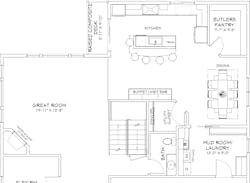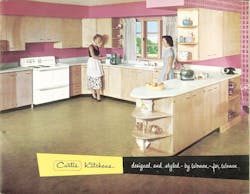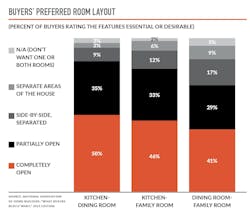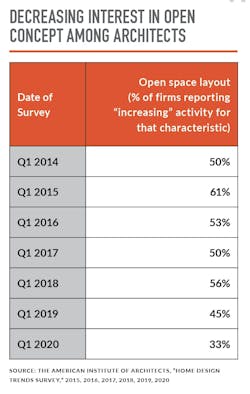The Life, Death, and Future of the Open Concept
That a floor plan could attract controversy is a novel idea. Still, the open concept has a few.
Credible people have called the layout an “exasperating privacy killer,” “a terrible idea,” “rooted in a sexist understanding of labor,” and “trendy because HGTV execs think men crave destruction.” It’s been said that the floor plan is “tyranny” and that it should be put to “death.”
It’s also been observed to be wildly popular.
“Almost every day someone asks me to open up a floor plan,” says Rob Smith, owner of E2 Homes in Maitland, Fla., a suburb of Orlando.
In Wisconsin, Chris Egner, remodeler and current president-elect of the National Association of the Remodeling Industry, says that the majority of his big projects involve connecting living spaces. “Seventy-five percent is opening a wall between the kitchen and living room.”
The open floor plan has a contradictory kind of popularity. It’s so widespread you can’t avoid it, but it’s also a floor plan that people sometimes love to hate.
We looked into why, and what’s changing because of it.
Open Concept Layout: An Origin Story Based in Stereotypes?
The earliest examples of opened-up living spaces are found in the roots of Prairie-style architecture, with connected living and dining rooms appearing in designs by a young Frank Lloyd Wright as far back as 1901. The modern interpretation of the floor plan, however, which incorporates thekitchen and connects the outdoors, was popularized by way of the ranch and split-level home proliferation of the ‘40s and ‘50s. Some architectural historians also give credit to the period’s widespread preference for bungalows, certain styles of which featured partially open kitchens.
There’s no denying part of what sold this new open arrangement to popular America at the time was that it gave someone working in the kitchen—at the time presumably a housewife—a line of sight to the majority of a home’s living space. It allowed a person to, say, monitor two kids in two different rooms without having to leave meal prep—which sounds like a two birds with one stone arrangement, but historian Ruth Schwartz Cowan would point out that increased foot traffic between the indoors and outdoors, encouraged by the layout, ended up creating more work for whomever managed the house.
It’s been said that the layout’s “idealized notion of efficiency” helped “justify” the kitchen’s initial incorporation to the open concept.
Gender roles aren’t as tightly defined or strictly imposed these days, but it makes sense that a person might take offense to the notion that antiquated gender roles influenced their floor plan; and it would make sense if that dulled the design’s contemporary appeal—which it may. But despite that bit of history or its possible connotations, keeping an eye on family is still something selling the open concept.
“I have a client right now with three kids, and she wants eyes on them at all times, even when they’re playing in the yard,” says Gabe Sepulveda, a senior interior designer at Jackson Design & Remodeling in San Diego. “So we’re opening things up to the outside.”
Open Concept Challenges
A few facts about the open concept that seem contrary to its apparent popularity is that it generally requires more design work by remodelers and more money from homeowners.
"Almost every day someone asks me to open up a floor plan"
“I wouldn’t consider the layout a problem, but it does create some design challenges you have to work through,” says remodeler Egner. “The layout removes a lot of interior walls, some of which may be weight-bearing. But you can replace those with load-bearing beams. And there are problems with mechanicals—plumbing and HVAC, specifically—that you have to address early on in the design phase.”
As far as price goes, an open concept renovation is not generally a budget-sensitive solution. “It’s certainly not cheaper,” says Smith of E2 Homes. “And it’s harder to hide things without ceiling headers and bulkheads.”
HGTV’s Influence on the Open Concept
The country’s acceptance, or overlooking, of those realities may be the responsibility of HGTV, which has been accused of “imprisoning” the public within the open concept.
In December 2019, journalist Ronda Kaysen, who co-authored The New York Times: Right at Home: How to Buy, Decorate, Organize and Maintain Your Space, revealed in an interview with NPR that executives at HGTV, a network partly made popular by shows pushing open concept floor plans, had in front of her discussed what was behind the promoting of the layout.
“I spoke with HGTV executives. The reason that they are so big on open concept is because it gets the male viewers … It’s not for, like, what’s the best interests of the house, necessarily,” said Kaysen during the interview. “Dudes will only watch HGTV if there’s sledgehammers. This is how you get your boyfriend to sit with you on the couch and watch it if you get to watch Jonathan Scott, like, knock down a wall.”
It’s a wild and weirdly ironic claim that feels as though it gives HGTV maybe too much credit, but turns out there may be some truth to it. After all, HGTV airs in 86 million households, it’s a top 15 network, and its website alone attracts 10 million viewers a month.
Consider some of the network’s most popular remodeling shows: “Fixer Upper,” “Flip or Flop,” “Brother vs. Brother,” “Property Brothers” (the latter two starring the aforementioned Jonathan Scott alongside his brother Drew Scott), all of which are million-plus viewer shows made famous by wall busting, smashing, and cutting, while also first airing between 2011 and 2013.
While by no means definitive evidence of anything but a correlation, online interest in the search term “open concept” did begin its public ascent around the time those shows started hitting airwaves. The current popularity of the term has virtually never been higher. Meanwhile, the majority of HGTV’s programming is now remodeling-focused, with three shows starring the open-concept propagating Scott brothers.
Conflicting Data on the Popularity of the Open Concept
So maybe outdated gender roles and HGTV have made the open layout more popular in American homes than the floor plan might have been otherwise. Of course, there’s no way to really know that. But we can at least agree that the floor plan is popular, right? There is data on the matter, after all.
Other data sets recount a different story.
While NAHB’s numbers suggest strong popularity for the open concept, American Institute of Architects survey results since 2015 have shown an overall, though perhaps wobbly, decline in the number of firms reporting increased requests for open layouts in home designs. In 2015, for example, 61% of architects reported new demand for open concept floor plans; that figure has fallen steeply to 33%.
“You hit the nail on the head when you say conflicting data,” admits Alexandra Isham, a senior program manager at NAHB and a member of NAHB’s Design Committee. “Trends come and go, with people claiming they’re gone, going, here to stay—and the same people may claim a different fate depending on the time of day.”
A New Open Concept Post-Pandemic
The conflicting message may be a simple lack of data inputs. Most housing data focuses on price and square footage rather than interior arrangement of the rooms. There is no entity keeping track of what floor plans people currently have in their homes.
Anecdotally, at least among the insiders to whom Pro Remodeler has spoken, there seems to be no doubt that open concept is in demand from coast to coast. “It’s not something that we’re pushing,” says Sepulveda, who is based in San Diego. “It is something that the client wants.”
In Florida, Smith says the much-discussed open concept layout is so popular that “any new home with it is moving quickly.”
But how the concept is described and implemented may be changing.
“NAHB staff, especially on the Design Committee, talk to builders and designers all day, every day, and not one has said the open concept is gone,” says NAHB’s Isham. “What we are hearing, though, is a redefined open concept, a more thoughtful open concept—and that was true even pre-pandemic.”
Open Concept Kitchens: Rooms Without Walls
Isham adds “pre-pandemic” because there is a wave of early data suggesting that the pandemic has changed how people view their homes. NAHB’s own data shows 25% of homeowners agree that COVID-19 has changed their housing preferences—although how their preferences have changed is unclear. Isham’s point, though, is that popular changes to the open layout are not impulsive reactions, but instead are rooted in long-shifting preferences.
“I don’t really think the pandemic accelerated people wanting more intimate spaces in an open layout,” Smith says. “Maybe more office spaces.”
More of what remodelers are seeing and, in Isham’s case, hearing, is that while the open concept remains a priority for many homeowners, designing the space well so that the absence of walls isn’t so obvious. That’s a tricky task, given that connected living spaces can feel like “singular, cavernous voids.” But thoughtful, inventive solutions can help.
“You are seeing more creative ways to shift up spaces,” Smith says. “You can do it with lighting changes, colors, and floor selections. You can do it with borders and accent colors. Furnishing is also a great way to define a smaller space in a bigger space.”
Materials can be an effective tool for sectioning the open concept, says Isham, and so can ceiling details. “We’ve seen remodelers drop part of the ceiling to define a kitchen from family room space.”
Covid's Influence on the Open Concept: Flex Everything
What may be more pandemic-propelled is usage of the word “flex” in floor plan design.
“People want flexibility,” Isham says. “Flex rooms, flex furniture—imagine your kid has school work to do, but you’re also working in the kitchen. People more and more are wanting the option to physically close off space.”
Nobody was more greatly impacted by the pandemic so far as their housing preferences were concerned than families with a virtual student and a teleworking adult, according to NAHB’s data. “Telecommuting flexibility is likely to be the norm across much of the nation even after the pandemic recedes,” reads the association’s latest “Remodeling Trends & Insights” report.
“I don’t really think the pandemic accelerated people wanting more intimate spaces in an open layout. Maybe more office spaces.”
One response from remodelers is creating new, small spaces that adjoin the open floor plan rather than disrupt it.
“People don’t envision themselves working from home forever—they just want flexibility,” Egner says. “It’ll probably result in more flex rooms on the main floor that could be an office or a bedroom.”
Smith has already seen rising requests for dedicated office space, though he notes it ultimately hasn’t impacted the openness of the home. “We’ve been converting a lot of second bedrooms into offices, but it doesn’t affect the central component of the home.”
NAHB’s Isham has also come across adjoining office space. “A pocket office that can also be a kid’s craft room is definitely something we’re seeing more of,” she says. But the association is also hearing about more subtle changes to the central space, “like flex furniture.”
Flexibility in this case refers to functionality. It’s a kitchen island with an extension leaf for extra work space or a moveable partition to provide privacy where it otherwise isn’t. Sepulveda has been using sliding glass panel systems to essentially create an open floor plan with doors—a considerable challenge considering the style’s aversion to interior walls.
“I have one client right now who we’re installing 24-foot-long doors for because they want the open concept, but also the option to close things off,” Sepulveda says.
In other words, homeowners today want the open concept, but with more adaptability for today’s lifestyles.
This is really the evolution of popular architecture in real time. In the same way the ranch and split-level home—and a “sexist understanding of labor”—helped standardize the modern, kitchen-incorporating floor plan, the pandemic is pushing forward new preferences that will soon reflect today’s vision of the open concept floor plan.





